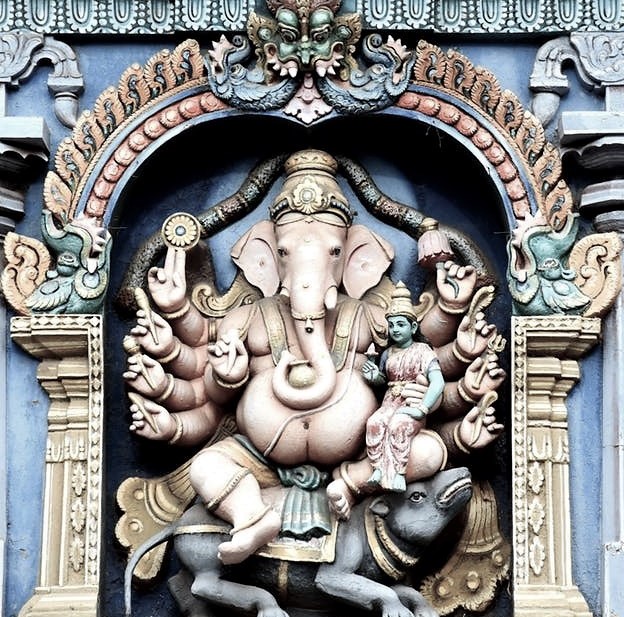- Special FeaturesFoundation Year1200 years agoSthala TreeJack fruit TreeTheerthamNarasimha Theertham ( Kamalalayam - sacred theerthams inside the rock )RathamArchitectureNarasimha Kudavara TempleOther Speciality
- Sthala Puran
Narasimhaswamy temple in Namakkal, a town in Namakkal district in the South Indian state of Tamil Nadu, is dedicated to the Hindu god Narasimha, an avatar of Vishnu. Constructed in the Dravidian style of architecture and Rock-cut architecture, the temple is located in the Salem - Namakkal- Trichy Road. The legend of the temple is associated with Narasimha, an avatar of Hindu god Vishnu appearing for Lakshmi, his consort, and Hanuman. Based on the architectural features, historians believe that the temple was built during the 8th century.
The temple has a pillared hall leading to the sanctum, which has rock-cut architecture. The temple is open from 7:00 am – 1:00 pm and 4:30 - 8:00 pm. Four daily rituals and many yearly festivals are held at the temple, of which fifteen-day Panguni Uthiram festival celebrated during the Tamil month of Panguni (March - April) when the image of presiding deities are taken around the streets of the temple, being the most prominent. The temple is maintained and administered by the Hindu Religious and Endowment Board of the Government of Tamil Nadu.
- Architecture
The temple is located along Namakkal-Salem road in Namakkal town, Namakkal district in Tamil Nadu. The temple carved out of an imposing hill, is located in the downhill of the Namakkal Fort, on the western flank of the hill. The temple has a flat gateway tower and a second entrance, also with a flat gateway leading to the pillared halls. The main sanctum sanctorum houses the image of Lord Narasimha in sitting posture, called Asanamurthi with two images under his feet. The sanctum is rock-cut and square in shape with a black background. The sanctum has three sculpted cells, two pillars and a verandah in front of it. The image of Narasimhar is treated as a Yogasana image, with the images under his feet seen to be the Sun and the Moon. It is not called a Bhogasana as the consorts on either side of him are absent. He has Shiva and Brahma on his either sides and he is sported with two hands holding the conch and the chakra. There is a panel depicting the narrative of Varaha avatar of Vishnu, who takes water from Bali and later grows big as Trivikrama to submerge Bali under his feet as per the Skanda Purana. Historians consider this as a deviation from the monoscenic sculptures in temples of Kanchipuram and Mahabalipuram.
The temple has other sculptural relief on the walls of the temple depicting Trivikrama, Narasimha slaying Hiranyakasipu and Ananta sayana Vishnu. The temple tank, Kamalalayam, is located outside the temple. There are similar rock-cut images in the temple halfway up the Namakkal Fort. Of note, it was in front of Namagiri Narashimhar that Saint Purandaradasa composed his famous song "Simha Rupanada Sri Hari, Namagirishane".
The temple complex houses two other sanctums. These sanctums house Namagiri Tayar and Sri Lakshmi Narayana.
Goddess Namagiri Lakshmi fondly called as Namagiri Tayar was the family Goddess of the renowned Mathematician Srinivasa Ramanujan. Ramanujan credited his acumen to his family goddess, Mahalakshmi of Namakkal. He looked to her for inspiration in his work, and claimed to dream of blood drops that symbolised her male consort, Narasimha, after which he would receive visions of scrolls of complex mathematical content unfolding before his eyes. He often said, "An equation for me has no meaning, unless it represents a thought of God."
There are number of sacred bathing places or thirthams in hollows in the sides of the rock and the largest of them is called "Kamalalayam" which is sacred to Lakshmi.
Name of the structure - Narasimha Kudavara Temple
Name of the king - Adhiyan rulers
Century - 7th century
Details of the structure - Arulmigu Narasimha Temple was built as a Kudavara temple during the reign of the Adhiyan dynasty kings, and the main deity Arulmigu Narasimha Kudavara is carved in relief. Later, stone mandapams and stone pillars with sculptures were built.
- Alankar of Deity
As per Hindu legend, Hiranyakasipu, a demon king, was troubling the Devas (celestial deities) as he got a boon from Brahma that no human can kill him, neither could he be killed in morning, noon or night nor in air, water or ground. His son Prahlada was an ardent devotee of Vishnu, garnering the hate of his father. Hiranyakasipu tried to slay Prahalada at various times, just to be saved by the divine grace of Vishnu. During the last heated argument between the two, Hiranyakasipu was asking if Vishnu was present everywhere and went on to break a pillar with his weapon. Vishnu took the avatar of Narasimha and came out of the opening in the pillar. Narasimha was a half-human with a lion face and slayed Hiranyakasipu on an evening time in a doorway, which was neither land nor air.
Ages past by, when Lakshmi, the consort of Vishnu was doing penance at this place, seeking his boons. Hanuman (locally called Anjaneyar) was carrying an image made of Saligrama and Lakshmi requested him to help her with a view of Vishnu in the form of Narasimha. Hanuman entrusted the saligrama to her and requested her to hold it until he returns. Lakshmi could not bear the weight and placed the image at this place, which grew into a mount before Hanuman could return. Narasimha appeared before both of them and set his abode at this place.
- Prayers and BenefitsSpecial Vratas and Prayers
Speciality - Prayer
Educational Development
Marriage Blessing
Child Blessing
Career Growth and Development
Debt Relief
Offerings to DeityStotras and Mantraslakshmi sahasranamam
- Festivals
- Sodasha Upcharas
- PrasadhasYes , Being distributed by Temple devasthanam
- Social ActivitiesAnnadhanMarriageEar BoringHead ShaveDanaasEducation FacilitiesSocial DrivesOther Activities
- Arjita Seva
- Tags

